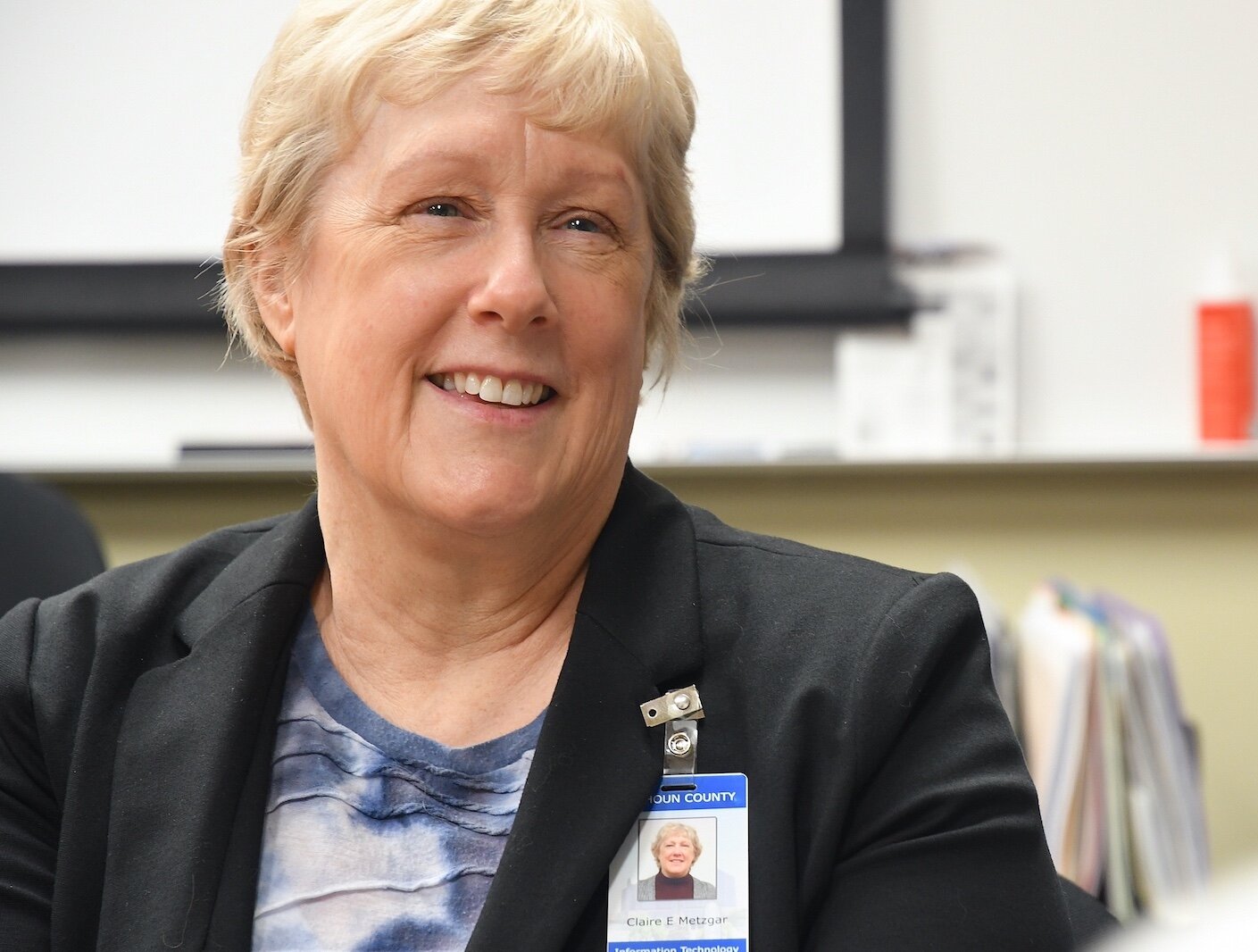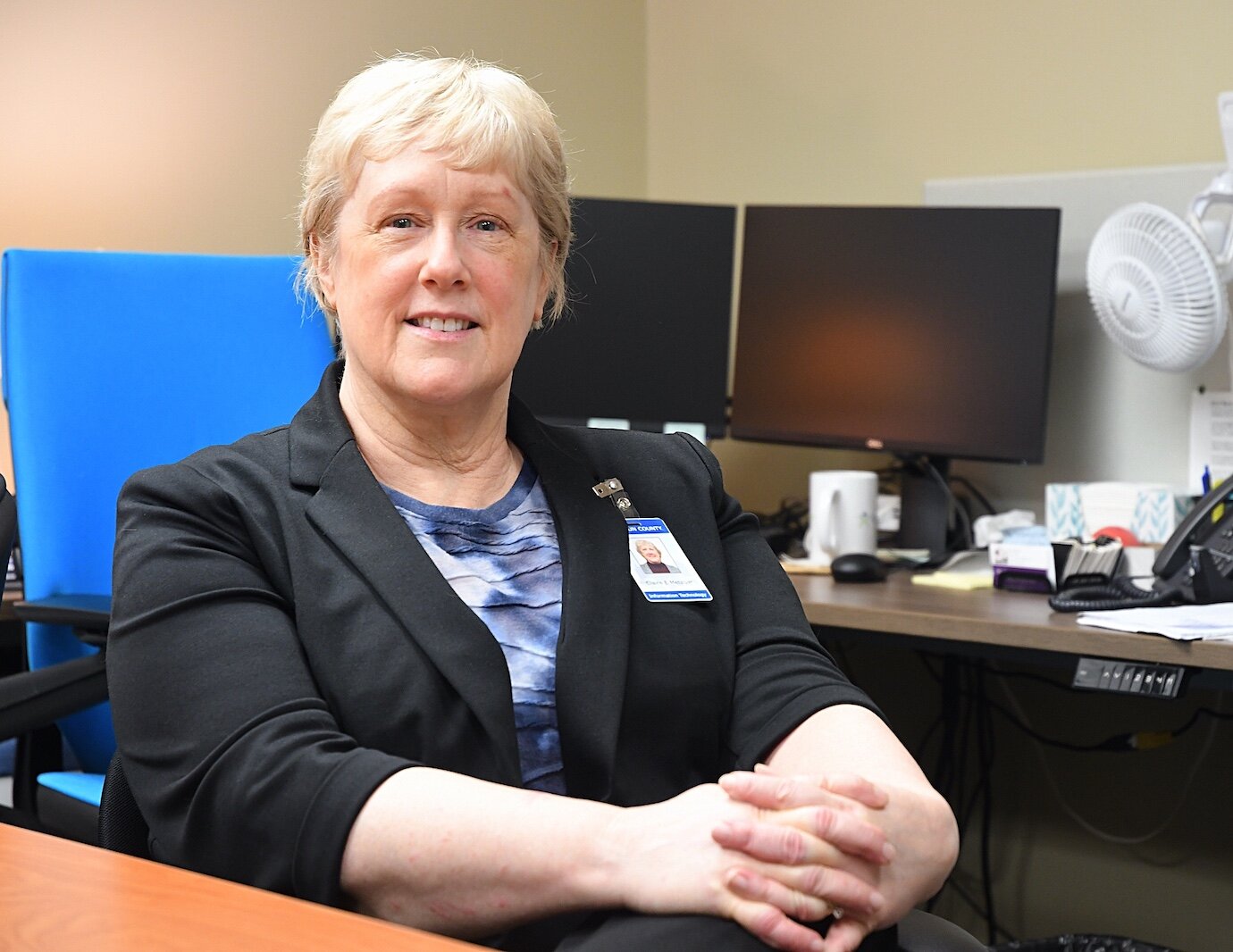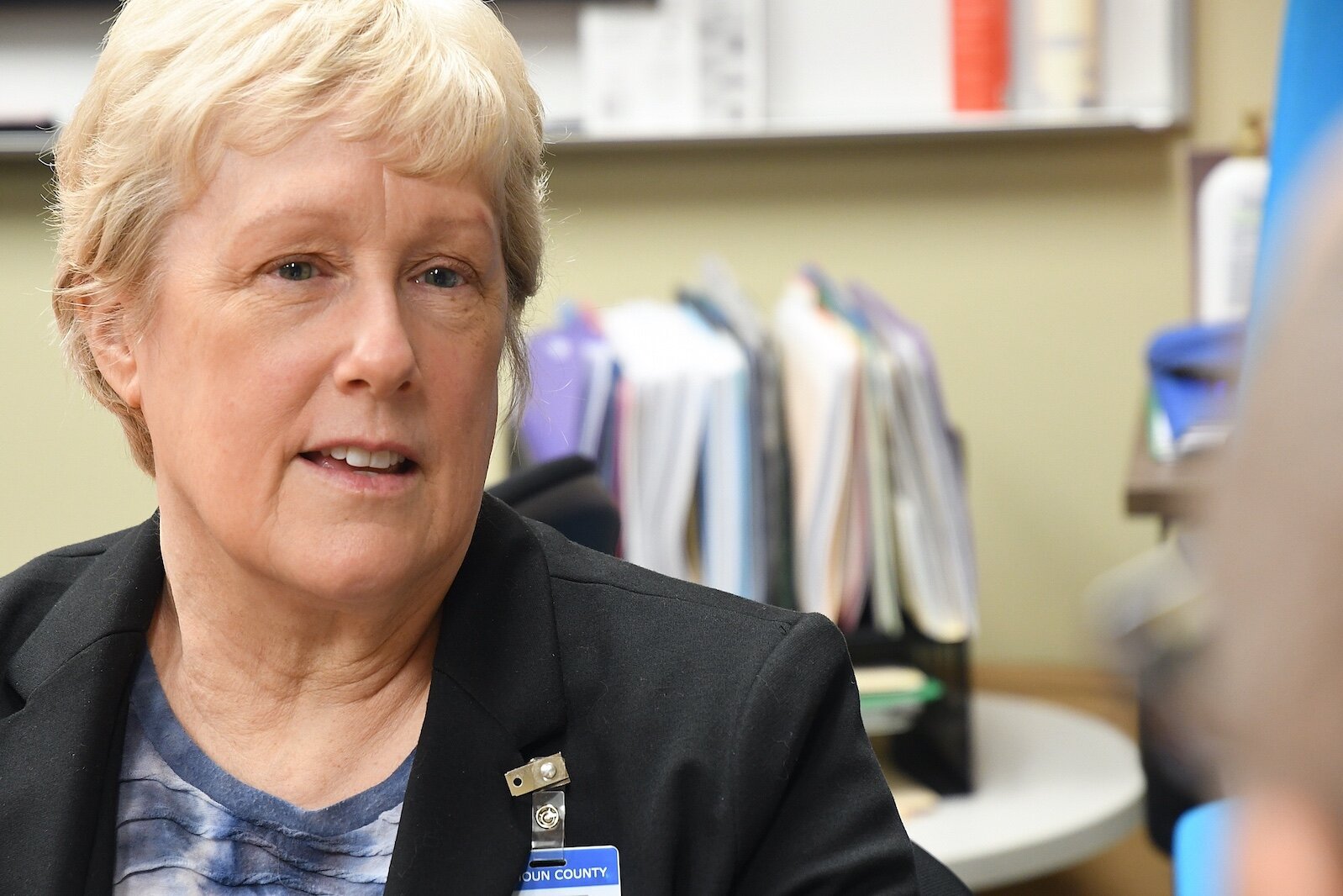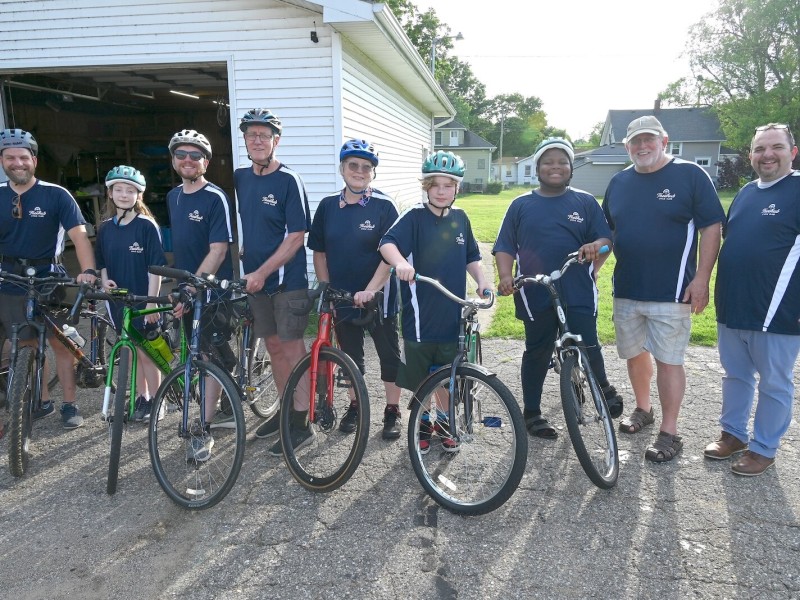This On the Ground Battle Creek story is part of the Mental Wellness Project, a solutions-oriented journalism initiative covering mental health issues in southwest Michigan, created by the Southwest Michigan Journalism Collaborative. SWMJC is a group of 13 regional organizations dedicated to strengthening local journalism. For more info, visit swmichjournalism.com.
Claire Metzgar knows that taking a deep dive into the lives of individuals she connects with at Calhoun County’s Public Defenders Office will not keep them from being incarcerated for the criminal activity that brought them to her. Instead, her main focus as the office’s Social Work Coordinator is to keep those she works with from having any further interactions with the criminal justice system after they have served their time and are released.

On Jan. 4, Metzgar joined the staff of 18 attorneys at the county’s Public Defender’s Office as part of the statewide Social Work Defender Project funded through the Michigan Indigent Defense Commission. In this role, Metzgar works with clients seeking legal representation from the Public Defender’s Office and its attorneys assigned to represent them to create a narrative that includes factual information about how these clients came to be in the criminal justice system.
The county’s Public Defender’s Office is one of three organizations in Calhoun County that have established relationships and work to provide mental health services to those who have too often in the past become statistics in the criminal justice system when what they really need is access to mental health services and treatment. The other organizations — Summit Pointe and the Battle Creek Police Department — each have implemented programs and services that are showing success, while also highlighting challenges they face.

From Metzgar’s perspective in her role with the Public Defender’s Office this means not looking at a person from a “one-demensional perspective.”
“I connect with them to see how that person came to the court’s attention which in turn provides the court or the attorneys with better information or a narrative to assist with mitigation,” she says. “That’s what my program is hoping to do while also working with clients to identify areas in their lives where they need to make some changes and assisting and identifying resources for them.”
In the majority of cases the resources include mental health services because the majority of clients served by the Public Defender’s Office have mental health issues. A significant number of them are also dealing with substance issues, says David Makled, Calhoun County’s Chief Public Defender.
“Across the board, the majority have one or both,” he says. “Substance abuse and mental health issues are a huge part of why people end up in the criminal justice system and once we start to accept and understand that, there will be more resources and attention given to it.”
Makled says Metzgar’s work is an example of a Holistic Defense Model. That model has been shown to reduce the likelihood of time spent in incarceration by 16 percent, and actual incarceration sentence length by 24 percent, according to a study conducted by the RAND Corp. and the University of Pennsylvania’s Carey Law School. Makled’s office is now the 11th in Michigan to have at least one social worker as part of its team of defense attorneys.

Since coming to work for Makled and his team, Metzgar has seen the difference having these resources makes in the lives of her clients.
Within the last two months, she’s worked with a young woman who had a “pretty heavy fentanyl dependency and came from a pretty horrendous family history,” Metzgar says. “She just had a lot of strikes against her. She came from a family with rampant drug abuse and mental health issues. When she was younger, she discovered her mother dead from a drug overdose. She has a long history of depression and post-traumatic stress and abandonment issues from finding her mother dead.”
The attorney assigned to prosecute her case offered her a plea deal after speaking with Metzgar who shared the young woman’s backstory. In addition, Metzgar was able to secure a place for her in a facility that could address all of her issues. Medicaid covered the cost.
“She never had the treatment she needed,” Metzgar says. “I found a facility that specialized in dual-diagnosis treatment (for mental illness and substance abuse) and had a nice continuum of services where you start in inpatient and when you get better you go into a rehab house and then you’re moved to outpatient.”
This was a successful outcome, but it is by no means the norm. It is not uncommon for her clients — or anyone in need of immediate mental health services in Calhoun County — to have to wait anywhere from days to weeks.
A lack of mental health professionals to serve the growing numbers of individuals in need of help, coupled with high rates of burnout in that profession contribute to these wait times, says Jeannie Goodrich, CEO of Summit Pointe.
In March 2021 Summit Pointe opened its First Step facility, which provides immediate care for adults and children experiencing mental health issues including suicidal thoughts, depression, or anxiety. The building that houses First Step is near the Bronson Battle Creek healthcare campus and Grace Health. Since its opening, more than 3,300 individuals have received some type of service through First Step, Goodrich says.

“Too often these individuals come to emergency rooms at local hospitals that don’t have staff with the expertise to adequately address their issues,” Goodrich said in an earlier story. “Being near the Bronson Battle Creek healthcare campus and Grace Health will enable hospital staff to direct these psychiatric patients to First Step, a psychiatric urgent care center.”
Every individual who comes in to First Step is screened for mental health symptoms and the outcome of that screening “tells us what the need for services is,” Goodrich says. “We could be recommending you for inpatient or outpatient care. If you have severe mental illness, we would be recommending services through Summit Pointe. A little over 80 percent of what we see are meeting that mild to moderate need and we refer them back to a local outpatient provider or a primary care provider.”
She says the pent-up demand for services as a result of COVID and the opportunity to access immediate care could be behind the higher numbers of those with mild to moderate symptoms.
Goodrich says she was anticipating that the needs of those who are seen at First Step would be equally split between those with severe symptoms and those with mild to moderate symptoms.
Those who are seriously mentally ill or have serious mental health issues are immediately placed in Summit Pointe’s case management system and work with mental health professionals or recovery coaches depending on their needs.
“If somebody comes in and meets the criteria for inpatient services, we work with the hospital and try really hard to make it easy on the patients so they don’t get bounced around,” Goodrich says.
However, those with mild to moderate symptoms will likely be waiting for a “couple of weeks” to receive treatment, she says.
“That’s been a consistent issue,” Goodrich says. “We went out and captured a very lengthy list of people in the community who can take those referrals. They’re starting to have long wait times. That’s why with that additional Certified Community Behavioral Clinic funding through the Substance Abuse and Mental Health Services Administration (SAMHSA) we have implemented a care coordinator so that when someone represents today with mild to moderate mental health issues and can’t get in for a couple of weeks the care coordinator is following up with them making phone calls, asking if they need to come in to see a mid-level provider until they can see a mental health professional and making sure they are following through and getting to their appointments.”
Metzgar says having someone assigned to be there for an individual dealing with non-severe mental health issues is critical to a successful long-term outcome. She speaks from experience. Finding and securing spaces for her clients at an in-patient treatment facility has been challenging and in a recent case led to an outcome no one wants to see.
“Unfortunately, I had one case where I had it all set up and it didn’t go fast enough. The person went back to using drugs and he overdosed,” Metzgar says. “There’s a lot of negotiation that goes into finding a space for someone with multiple issues. At the same time, you’re actively working with the client to make sure they’ll be OK until their next appointment and developing a crisis plan.
“The lack of mental health providers is really slowing things down and they may be dealing with their own burnout. I’ve had a number of clients complain that their counselor cancels on them. I’m hearing constantly from direct care providers that there’s such a need and it never stops.”
A safety net, a work in progress
In March 2021, the Biden Administration announced that it would provide nearly $2.5 billion in funding to states and territories to address the nation’s mental illness and addiction crisis, which had worsened during the COVID-19 pandemic, according to information on the (SAMHSA) website. SAMHSA directed $1.65 billion in Substance Abuse Prevention and Treatment Block Grant funding and $825 million in Community Mental Health Services Block Grant funding to states and territories.
In May, SAMHSA distributed $3 billion to states and territories to support key county mental health and substance use programs. The funding was authorized under the American Rescue Plan Act of 2021 (ARPA) and follows the approximately $2.5 billion in funding SAMHSA issued to the programs in March. The $3 billion in funding will be split between the Community Mental Health Services Block Grant (MHBG) and Substance Abuse Prevention and Treatment Block Grant (SABG) programs, which will each receive $1.5 billion to disperse to state and territorial grant recipients. While counties are not direct grant recipients of the programs, they receive sub-allocations from the state.
Goodrich says funding is definitely at the top of the list for mental health providers. She says Summit Pointe has been receiving $1 million annually since 2020 through a SAMHSA grant. She says this is in addition to other grants she applies for. She says she will continue to apply for the SAMHSA grant funding with the end goal being the transition to a Medicaid funding model which she says will be more sustainable.
Among the questions she has been wrestling with, “As COVID winds down, what does that mean for our funding?”
The ARPA funding Summit Pointe has received has been used to hire two additional full-time staff at First Step and a staff member who works with inmates at the Calhoun County Jail prior to and after they are released. They evaluate their needs to see what they will help and that could include a recovery coach and case manager.
But Goodrich says this is not enough. In the last 18 months Summit Pointe, which has 250 employees, has had up to 35 open positions. That number is now down to 20 and the competition for these mental health professionals is stiff.
“If they’re not working for a school system, with us, or Grace Health, they go into private practice,” Goodrich says. “I keep an eye on benefits and wages all the time. We’re trying to remain competitive with other counties and community mental health organizations. We don’t compete with private markets and others. We try to compete with other CMH’s (Community Mental Health organizations). We’re reaching out and recruiting differently and seeing if there’s a different level of a position, I can bring in.”
She says it’s an ongoing issue with many nuances, including recruitment efforts that may take someone out of a school system that will negatively impact that school system’s staffing levels and ability to provide mental health services to students. The resources and the pool of candidates available is “small,” she says.
This lack of funding and resources also is being felt by the Battle Creek Police Department. It has a goal of getting each of its 98 officers through Crisis Intervention Training. Currently, 25 percent of officers have undergone the training, says Battle Creek Police Chief Jim Blocker.
“We have 98 officers there’s less than 40 that are assigned to work the road,” Blocker says. “I should have 122 officers. This is an example of how our resources and personnel are constrained.” That number — 122 — is based on authorizations and allocations set by the Battle Creek City Commission.
Adding to these constraints was COVID which limited the number of officers that could be in a training. Coming out of COVID, Blocker says he would like to have Crisis Intervention Training monthly through August, but has to be mindful of the added stress that will put on officers who would end up working additional shifts to cover for their colleagues undergoing the training.
“We need to plan these sessions in such a way that it doesn’t overburden the employees themselves,” Blocker says. “It’s hard to work all night and sit in a classroom all day.”
However, these obstacles are set against a backdrop of successful outcomes. Since the BCPD began the Crisis Intervention Training program in 2018, officers have handled 1,242 crisis intervention calls for service. Blocker says the use of force resulting in the handcuffing of the perpetrator was used in 6 percent of these cases.
“Out of the total number, 16 percent had chargeable offenses and the total number that went to jail is a little over 1 percent which is really significant,” Blocker says. “Of that 1,242, 75 percent were either taken to a hospital or screening unit and some were taken to First Step.”
These numbers are tabulated by Summit Pointe, so the police department “can’t be accused of inflating the numbers,” he says. “This program is intensely successful. Those numbers continue to shock me. These are calls for service that are designated mental health calls. We have many after the fact that Summit Pointe would qualify. If you asked me how many folks go to jail, I would have said 90 percent prior to this mental health training.”
Officers must take a second look at every situation and every call for service to recognize if there are mental health needs because what a witness may observe may not really be happening, Blocker says.
“It’s up to the officer to arrive and quickly assess what he or she is dealing with. Is it a malevolent actor with bad intentions or the onset of a mental health crisis that may be untreated because they’re not taking their meds? This training gives officers other choices and provides opportunities to really change the results of interactions on a daily basis. It’s that de-escalation and recognition part that is so critical.”
That de-escalation involves mental health professionals from Summit Pointe who are available 24-hours a day to assist officers who identify the need for mental health services. This relationship was strengthened through the establishment in 2014 of the BCPD’s Fusion Center, a collaboration among community organizations and the BCPD which has streamlined the way officers respond to calls while providing the resources that better address the needs of those making those calls.
Officers are able to focus on calls involving criminal activity while giving representatives with organizations such as Summit Pointe and Safe Place the ability to address the needs of residents who seek out the police as their first line of defense.
“Sometimes just saying we’re going to lock you up and toss away the key and hope for the best, may not be what’s best for you or for society,” Makled says. “So much more is possible that they can do. We want to give them that option and the chance to be more than they are now and do something different.”
















